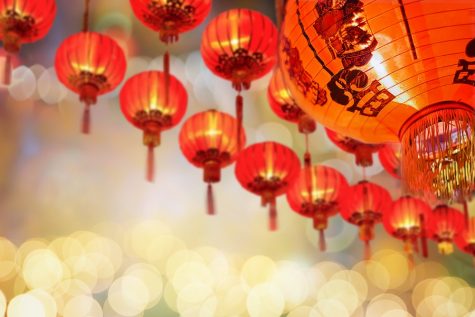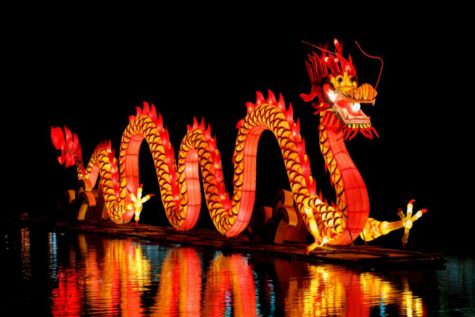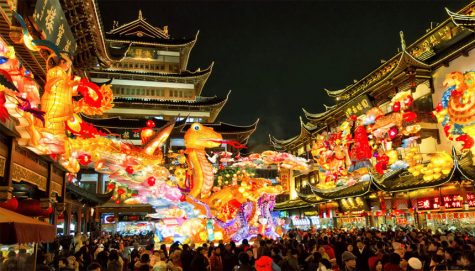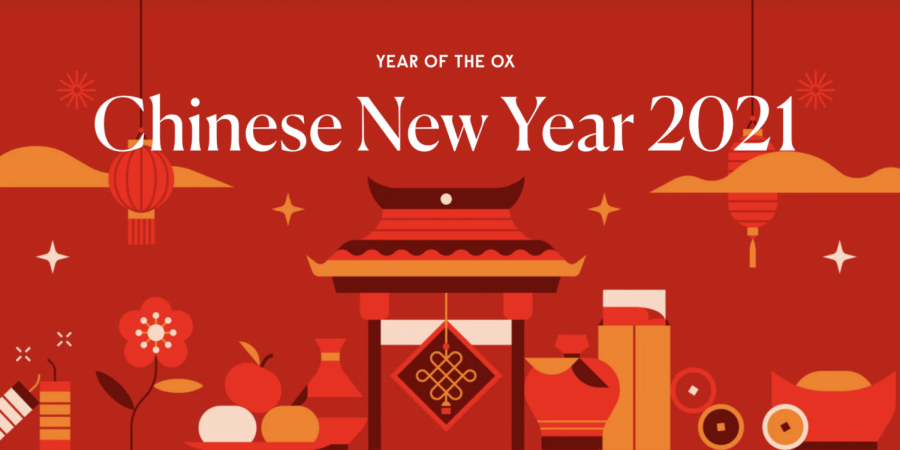Chinese New Year Traditions
Ahh, Chinese New Year. The time when flights are delayed, money is spent on gifts, and people stress about seeing family. Think Christmas, except apply it to over one billion people. Yet, this little-known-to-the-West holiday has many exciting aspects and traditions that make the event worth celebrating.
Wait, When Is Chinese New Year?
 Ever wonder why there is no set date every year? That is because the date is determined by the Chinese lunar calendar. Here’s a very oversimplified explanation: a “month” in the lunar calendar would be only around 29 days, meaning there would be only around 354 days in a year. This mismatch with the Gregorian calendar (our calendar) means that the date would shift back every year by around 10-12 days. In case you were wondering, the lunar calendar makes up for the missing 11 days by adding a leap month every three years. This year, it happened to land on today, February 12th! In addition, Chinese New Year is not only a single day celebration like its western counterpart, but rather the celebration lasts more than two weeks, 16 days to be exact! Often, many workers in China and other Asian countries take those days off to go home and celebrate with family. (but not the entire two weeks though, ‘cause you still gotta an economy to run)
Ever wonder why there is no set date every year? That is because the date is determined by the Chinese lunar calendar. Here’s a very oversimplified explanation: a “month” in the lunar calendar would be only around 29 days, meaning there would be only around 354 days in a year. This mismatch with the Gregorian calendar (our calendar) means that the date would shift back every year by around 10-12 days. In case you were wondering, the lunar calendar makes up for the missing 11 days by adding a leap month every three years. This year, it happened to land on today, February 12th! In addition, Chinese New Year is not only a single day celebration like its western counterpart, but rather the celebration lasts more than two weeks, 16 days to be exact! Often, many workers in China and other Asian countries take those days off to go home and celebrate with family. (but not the entire two weeks though, ‘cause you still gotta an economy to run)
Red, Red Everywhere

If you Google “Chinese New Year” and click on the images tab, you will notice a heck ton of red. The reason for the overabundance of red that’ll confuse red-green colorblind people? Red symbolizes luck, fire, joy, and good fortune (and a whole ‘nother mythology we’re not going to delve into). It’s customary for people to decorate their house with red lanterns, red banners, and the famed upside-down “Fu 福” logo. The last decoration actually is a play on words as “fu” means luck and “luck being upside-down” in Chinese is a homonym to “luck has come”.
The theme of red continues in clothing as members of the family wear traditional “qipao 旗袍,” “hanfu 汉服,” or “tangzhuang 唐装,” although modern celebrations allow for any clothing of red. In addition, parents and relatives often give kids “hongbao” (红包), or red packets, each stuffed with little gifts, usually money. Children would wait every year to get this beloved hongbao, which symbolizes giving good luck to the receiver. Red is also present in many of the festivities, such as lion dancing and continuous nightly fireworks.
It’s Not Just Fried Rice and Dumplings, Ya Know.

Just like Americans would on Thanksgiving, one of the primary goals of Chinese New Year is to stuff your face with food until you reach comatose, except you repeat this process for days. Chinese New Year means that the family kitchen will always be steaming with hot, fragrant food. There are a plethora of dishes eaten on Chinese New Year as each region in China (and other Asian countries that celebrate the holiday) and each family has their own take on the foods, but common occurrences are steamed dumplings (jiaozi 饺子) or wonton (馄饨), red braised fish or pork belly (hong shao yu 红烧鱼 or hong shao rou 红烧肉), stuffed fried gluten balls (油面筋), noodles of some variation, and assorted fresh vegetables. Don’t even get me started on the long list of desserts, with items like rice cake (nian gao 年糕) and tangyuan (汤圆) making frequent appearances. If you ever feel like you want to try Chinese food but don’t know where to start, go to a Chinatown during Chinese New Year where you’ll get all the greatest hits.
Common Festivities
 You might be wondering, what else do people do on Chinese New Year? Well glad you asked, because there are also a plethora of ways to celebrate it. You could go the traditional route: before the New Year, families would OBSESS with cleaning the house, so much so that it’s basically tradition. Just as New Year is a new start for many of us, cleaning the house symbolizes “sweeping out the dust” and bidding farewell to the old year. All the good food mentioned above is usually eaten on New Year’s Eve and it’s common for people to stay up until the morning hours. The CCTV Chinese New Year Gala (yes, it’s a state-sponsored program) is often watched, and it showcases and celebrates Chinese culture with music, performance arts, and more. On New Year’s Day, firecrackers are lit and fireworks light up the sky. On the streets, you’d find lion or dragon dances, both animals being important in Chinese culture. On the final day of the celebration, more fireworks are lit and lanterns are lit, greeting the New Year with joy and excitement.
You might be wondering, what else do people do on Chinese New Year? Well glad you asked, because there are also a plethora of ways to celebrate it. You could go the traditional route: before the New Year, families would OBSESS with cleaning the house, so much so that it’s basically tradition. Just as New Year is a new start for many of us, cleaning the house symbolizes “sweeping out the dust” and bidding farewell to the old year. All the good food mentioned above is usually eaten on New Year’s Eve and it’s common for people to stay up until the morning hours. The CCTV Chinese New Year Gala (yes, it’s a state-sponsored program) is often watched, and it showcases and celebrates Chinese culture with music, performance arts, and more. On New Year’s Day, firecrackers are lit and fireworks light up the sky. On the streets, you’d find lion or dragon dances, both animals being important in Chinese culture. On the final day of the celebration, more fireworks are lit and lanterns are lit, greeting the New Year with joy and excitement.
However, in the modern age, it doesn’t have to be 100% like the traditional way, especially for Chinese Americans that don’t always have access to the above. Any modifications–whether it be food, clothing, or festivities – don’t detract from the general feel of the holiday and the joy people have celebrating the new year.
Family First
Amidst all the celebrations, the stuffing of faces, and the festivities, the common theme of it all is family. Family reunions are a big deal on Chinese New Year, and throughout the week of celebrations, people would visit relatives they have not seen in an entire year. In addition, many families honor their ancestors during this time, visiting familial burial sites, lighting incense, and placing offerings such as fresh fruits. It really is a time to just be with family and catch up on all the things they missed, all while having fun and eating really delicious food.
Other Bits and Pieces
 The Chinese Zodiac that you see at a Chinese restaurant actually plays a significant meaning here. There are 12 animals in the zodiac (kinda like your star sign), and each year is represented by a different animal. They are, in order, the Rat, Ox, Tiger, Rabbit, Dragon, Snake, Horse, Goat (or Sheep), Monkey, Rooster, Dog, and Pig. Every 12 years, the cycle loops again, and whichever year you are born in, you are associated with that animal. Each animal has specific personality traits that also correlate with the person born in the year. Again, think star signs, but fancier and more rooted in the culture. There’s a whole story behind the zodiac that we’re also not going to delve into here, but this year is the year of the ox, and oxes are diligent and hardworking, yet stubborn and materialistic.
The Chinese Zodiac that you see at a Chinese restaurant actually plays a significant meaning here. There are 12 animals in the zodiac (kinda like your star sign), and each year is represented by a different animal. They are, in order, the Rat, Ox, Tiger, Rabbit, Dragon, Snake, Horse, Goat (or Sheep), Monkey, Rooster, Dog, and Pig. Every 12 years, the cycle loops again, and whichever year you are born in, you are associated with that animal. Each animal has specific personality traits that also correlate with the person born in the year. Again, think star signs, but fancier and more rooted in the culture. There’s a whole story behind the zodiac that we’re also not going to delve into here, but this year is the year of the ox, and oxes are diligent and hardworking, yet stubborn and materialistic.
And of course, COVID-19 definitely changes how this holiday is being celebrated. While China has done better in controlling the virus (that assertion is up for debate), some people are discouraged from visiting home because of fears surrounding the virus. In addition, many events are still canceled to prevent large gatherings of people. However, as the New Year begins, the people celebrating will still find a way to make merry with family and friends.

Derek Wong is a senior who likes discussing hot topics relating to politics and the entertainment industry. He frequently participates in Model UN, loves...

